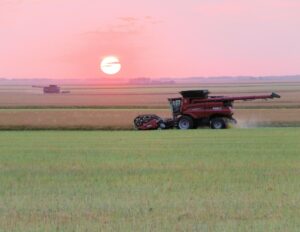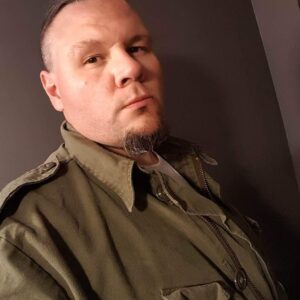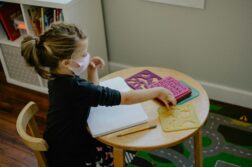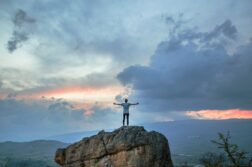
I would like to share with you a recent conversation I had with an older colleague at work:
“Did you say you’re LGBTQ?” She asked.
“I did, and I am,” I replied.
“But aren’t you married?”
“Yes…”
“To a woman?”
“Yes, for over twenty years now.”
“But then, how…?”
“What do you think the ‘B’ in ‘LGBTQ+’ stands for?”
(A Moment’s Silence)
“Those letters MEAN something???? I thought they just meant ‘gay’!”
It was an interesting, yet awkward, coffee break, to be sure.
I have been happily married to my wife, in a heterosexual relationship for over 23 years, and we have four teenage children, including a set of triplets. We live in an extremely conservative, rural community in the province of Saskatchewan, often called the “Alabama/Mississippi of the North,” where xenophobia and racism run rampant, shattering the myth of Canada as a bastion of tolerance and acceptance. It’s not exactly the safest place to be Indigenous, left-wing, or out.
To be queer in rural Saskatchewan can be dangerous at times. To be Indigenous in Saskatchewan is dangerous at all times. To be both takes a certain amount of survival instinct that can only be achieved when one is in a constant state of hypervigilance.
Prior to my marriage, my bisexual relationships were always clandestine, hidden and discreet. Being closeted wasn’t a conscious choice, but it was an almost instinctual survival method. As a member of Generation X, I saw no openly-gay people in my community, and that lack of positive representation resulted in an overabundance of negativity. Growing up in the ‘80s, watching films like Bill and Ted’s Excellent Adventure and its sequel, hearing Keanu Reeves and Alex Winters calling each other “fags;” watching hockey players beat the shit out of guys for standing too close to them, yet espousing their love of lesbian porn; and, on top of it all, the AIDS crisis, growing up while having feelings for both girls and boys meant that the choice of supressing one for the other to avoid getting beat up was a no-brainer.
I found subtle ways around it, though. When the dance component of eighth and ninth grade physical education would come around, we were forced to learn how to waltz and polka and foxtrot. I would wait until all the girls in the class were paired up with boys, so the gym teacher would pair me with another boy who didn’t get picked. It was a simple, nonsexual way of acknowledging that I liked boys as well as girls.
In spite of the cruelty of my toxic surroundings, I did manage to have a few meaningful relationships with men in my teenage years, though I mostly found myself in relationships with women. The scales have always been decidedly tipped in the direction of hetero, not as a matter of form, but in the simple fact that it was easier for me to find female, rather than male, partners. The opportunities just weren’t there for meaningful long-term and open relationships, outside of a purely sexual, hookup.
Being Indigenous, I am familiar with the long history of colonialism and genocide for the better part of the last five hundred years. With the destruction of our traditional and cultural ways came the forced westernization and Christianization of the First Nations, Metis and Inuit peoples of the Americas, which included clearly defined, misogynistic and patriarchal roles for males and females. These stereotypes led to forced chauvinistic beliefs, now often adhered to as “traditional protocol” within Indigenous culture, as well as the removal and vilification of individuals in Indigenous communities who were held in the highest and most sacred of positions and respect, including men who loved men and women who loved women.
In many traditional Indigenous societies, LGBTQ individuals were held in the highest regard as medicine people, warriors, and sacred beings. They would sit in both men’s and women’s councils; they would go to war and they would serve as matchmakers. These were holy people for thousands of years, yet, in the span of a few years, they were made taboo by the Church, so much so that, for many Indigenous groups, the traditional name in the language of that particular people was lost, and they were referred to by a vulgar French word which I will not utter here, and which is considered by many to be on par with the “N” word.
It wasn’t until 1990 when a somewhat pan-Indigenous umbrella term came out (pun intended), following an international gathering in Winnipeg, Manitoba. The term was “Two-Spirited,” and it refers to the traditional third-gender role once held by many in Indigenous societies, but has come to refer specifically to Indigenous people who identify themselves as such. It symbolizes walking with both the masculine and the feminine spirit within one body, and the sacredness of this role. In the alphabet soup acronym of LGBTQ2S+, it is represented by the letter and number “2S”
I do not consider myself Two-Spirited, for I do not fulfill that particular role in my people’s traditional society. That is a sacred role, and they hold medicine which differs from the cultural and spiritual path I am on. That being said, to see the role of the Two-Spirited members of the community returning to the level of respect that they once held, as incremental as the progress is, fills me with hope and optimism, as there is finally recognition for my own orientation that had been repressed for so very long.
This takes me back to that conversation I mentioned earlier. To acknowledge my bisexuality so openly took quite a long time, and it always runs the risk of incredulousness from those who are aware that I’m married to a woman and have kids. While it is true that it has been over twenty years since I’ve been in a relationship with a man, it’s always awkward to explain to others that my attraction to men isn’t something I ‘switched off,’ and that it is no different than a heterosexual relationship built on trust, love, and loyalty.
I always state that I am the “B” in LGBTQ2S+, and I am happy with myself for being able to say that and be open about it. It took a bit of time, but I’m okay with that. Besides, time is colonial construct, anyway.
 John Brady McDonald is a Nehiyawak-Metis multidisciplinary artist and writer from Prince Albert, Saskatchewan. He is from the Muskeg Lake Cree Nation and the Mistawasis Nehiyawak. John is the author of several books, and has had his written works published and presented around the globe.
John Brady McDonald is a Nehiyawak-Metis multidisciplinary artist and writer from Prince Albert, Saskatchewan. He is from the Muskeg Lake Cree Nation and the Mistawasis Nehiyawak. John is the author of several books, and has had his written works published and presented around the globe.







Discussion1 Comment
Great story… There are all types of discrimination. Women have been discriminated against for so many centuries… We are still second class citizens in my opinion. Thank you for illuminating your personal challenge.